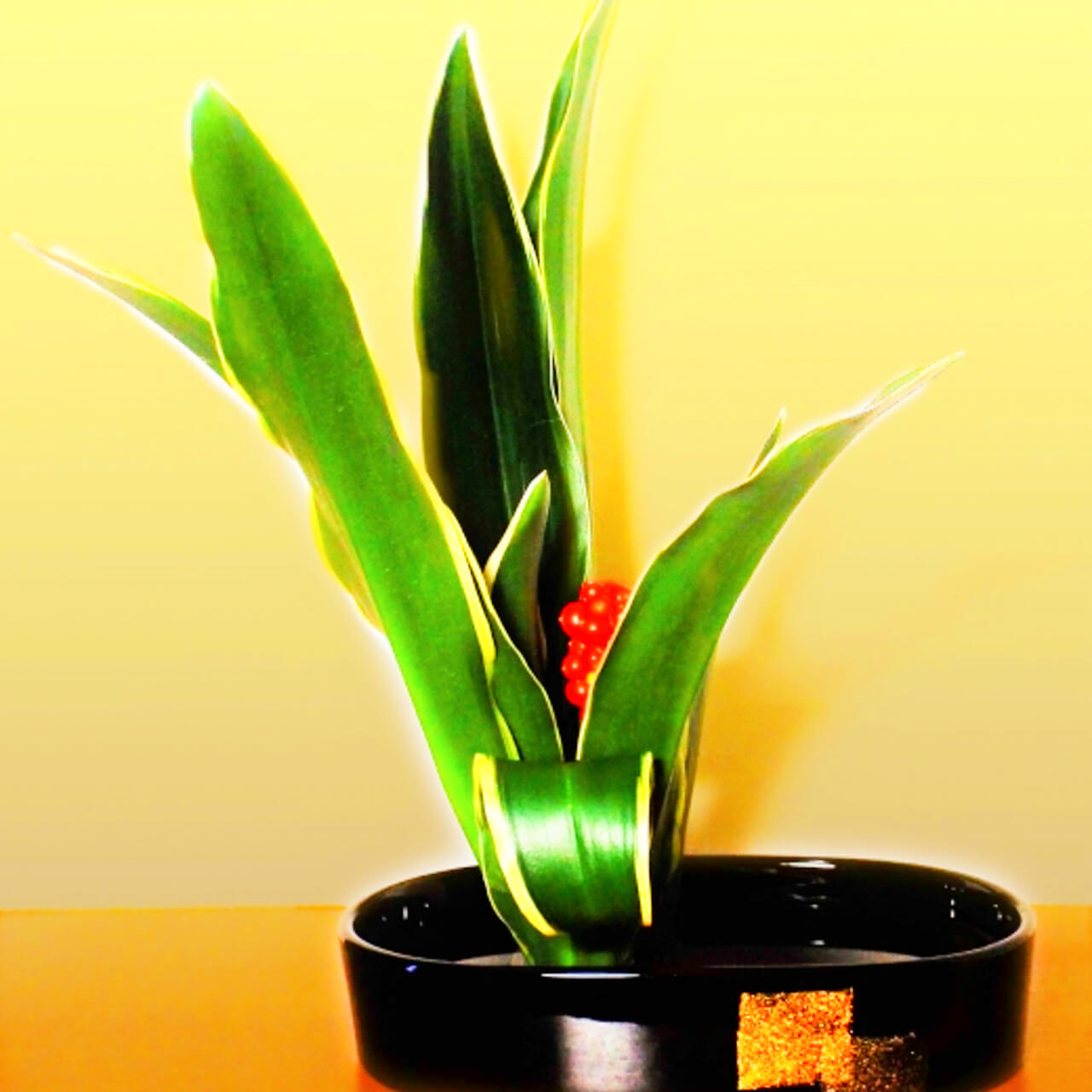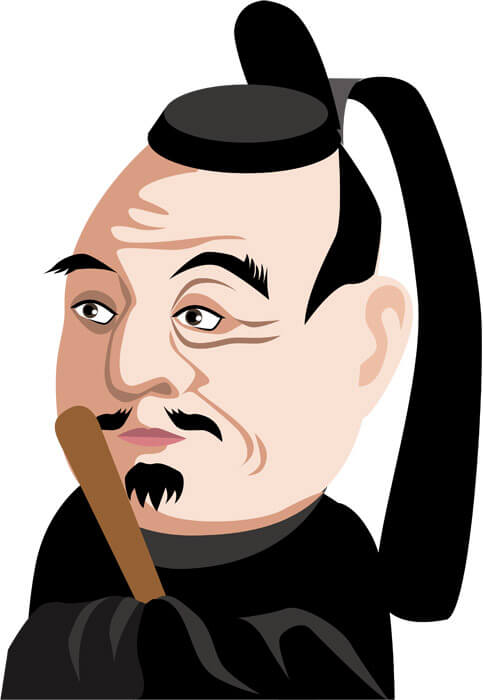Japanese Rohdea(万年青/omoto) has a long history of use as a medicinal herb, as a moving plant, as a celebratory plant, and as an ikebana(生け花/the traditional Japanese art of flower arrangement).
It was also an important plant in feng shui(風水), as in the case of sekkakushi omoto(雪隠万年青), where Japanese Rohdea(万年青/omoto) was planted beside the outside toilet to purify an unclean place, or in the case of moving to a new house, where Japanese Rohdea(万年青/omoto) was planted in the direction of the devil’s gate of the house.
Therefore, it is a wonderful plant for celebrating a new building or moving house.
Because of the wide variety of ways it has been used, it actually has a large number of aliases. It may even be the botanical with the most aliases of any plant!
We would like to introduce Japanese Rohdea Pattern(万年青文/omoto mon) as such an auspicious object from long ago!
About Japanese rohdea(万年青/Omoto)?

Japanese Rohdea(万年青/omoto) means evergreen perennial herb, referring to its appearance of staying green all year round without withering in winter. Japanese Rohdea(万年青/omoto) is an evergreen perennial plant of the lily family, which is why it was so named.
Native to the mountains of Japan and China, it produces numerous dark green leaves from a thick underground stem. The leaves are about 30-50 cm long, thick and glossy.
Every year in early summer, it puts out short stems and blooms small flowers in the shape of spikes, and in early winter, it bears beautiful red fruits. It is said that when Tokugawa Ieyasu(徳川家康/He is a historical person who survived the age of civil wars and is a founder of Edo shogunate.) entered Edo Castle(江戸城), he decorated the alcove with a fountain grass and entered the castle, which brought him prosperity.
The language of the Japanese Rohdea(万年青/omoto) flower is “longevity,” “noble spirit,” “long life,” and “maternal love.
Japanese Rohdea(万年青/omoto) is said to prevent misfortune when planted in a garden, and to help a house flourish for many years, because its green leaves grow thickly all year round. The words “longevity” and “long life” in the language of flowers seem to derive from this.
The red berries wrapped in dark green leaves resemble the image of a mother holding her child in her arms and caring for it, hence the flower’s name “maternal love.
The wild species of Japanese Rohdea(万年青/omoto) bear red berries around the New Year. The 400-year-old carvings of Japanese Rohdea(万年青/omoto) at Nikko Toshogu Shrine(日光東照宮) and Kitano Tenmangu Shrine(北野天満宮) are also carved with red Japanese Rohdea(万年青/omoto). Ikenobo(池坊/Ikenobo style is the base of Ikebana established by Senoh Ikebono.), an ikebana(生け花) school said to have a history of more than 600 years, places Japanese Rohdea(万年青/omoto) with red berries at New Year’s, weddings, and other celebratory occasions. The word “motherly love” was probably coined from the word “Mannensei” which means “maternal love” in Japanese, referring to the red fruit (the child) surrounded by the blue leaves (the mother).
Japanese Rohdea(万年青/omoto) horticulture was written in the olden times as “garden art(園藝/engei),” and the art means to put one’s hand on a plant and plant the soil. Geijutsu(藝術/art) was originally the noble person’s enjoyment of plants. It may be natural that “noble spirit” should be included in the language of flowers of fountain flowers, which have been developed as a hobby and flower arrangement of noble people since ancient times.
Japanese Rohdea(万年青/omoto) has more than 20 aliases, making it one of the plants with the most aliases. The names are given because of its involvement in various aspects of Japanese culture and history. By looking at the aliases of Japanese Rohdea(万年青/omoto), we can understand how Japanese people used to look at it and how they used it in their daily lives.
年青、萬年青、天福の霊草、霊草、老母草 冬不凋草 不老草 レイロ・リロ(藜蘆、藜芦、莉蘆、黎蘆)、縁起草、吉草、長寿草、辛抱草(しんぼうぐさ)、イワラン、烏木毒、蒀、於茂登、御許、母人、大本、大元、ももよ草、百代草、不毛草…etc
Japanese Rohdea(万年青/omoto) is a classic gardening plant that has been loved and loved for over 1,000 varieties and has been repeatedly crossed for 400 years in Japan as a plant of good omen of longevity and health because of its beautiful green leaves that always remain green and taut, as conveyed by the Chinese character.
【大葉系/oha kei】The leaves grow to 30-40 cm in length. This sprawling appearance is associated with increased fortune.
【中葉系/nakaba kei】There are three types as follows and they grow to a medium size of around 20 cm.
『薄葉系/usuha kei』It is a little smaller and has thinner leaves than the medium-leafed varieties(中葉系).
『獅子系/sisi kei』Unique shape with the tips of the leaves curled inward and the leaf artistry of curling the tips of the leaves into a wavy curl can be admired.
『縞甲系/simakou kei』Leaves slender and thick.
【羅紗系/rasya kei】Small, around 5 cm with overlapping, well-formed leaves.
In fact, the omotsu as a form of horticulture that we enjoy nowadays largely flourished during the horticultural boom of the Edo period (1603-1868).
Tokugawa Ieyasu(徳川家康)とJapanese Rohdea(万年青/omoto)
 It is said that Japanese Rohdea(万年青/omoto) sculpture(万年青彫刻/omoto chokoku) at Kunouzan Toshogu(久能山東照宮) was carved because Tokugawa Ieyasu(徳川家康) particularly cherished Japanese Rohdea(万年青/omoto).
It is said that Japanese Rohdea(万年青/omoto) sculpture(万年青彫刻/omoto chokoku) at Kunouzan Toshogu(久能山東照宮) was carved because Tokugawa Ieyasu(徳川家康) particularly cherished Japanese Rohdea(万年青/omoto).
Since the early Edo period (1603-1868), Japanese Rohdea(万年青/omoto) has been used for horticulture, and there is a legend that Tokugawa Ieyasu, the third shogun, entered Edo Castle carrying three Japanese Rohdea(万年青/omoto) plants presented to him by his subjects. Since the Edo period lasted for a long time after that, it is still regarded as an auspicious plant. At first, the plant was favored by feudal lords, but it gradually spread to citizens, and a boom in the mid-Edo period led to the creation of many garden varieties.
As mentioned at the beginning of this article, the history of cultivation of Japanese Rohdea(万年青/omoto) is said to be more than 400 years old.
It is said that when Tokugawa Ieyasu(徳川家康) entered Edo Castle(江戸城) in ancient times, one of his vassals offered Japanese Rohdea(万年青/omoto) to him. During the Edo period, it seems to have been cultivated mainly by feudal lords. Some books from the Genroku(元禄/Mid-Edo period, during the reign of Emperor Higashiyama, September 30, 1688 – March 13, 1704) to Kyoho period (享保年間/1688-1704) show spotted Japanese Rohdea(万年青/omoto).
From this time, cultivation seems to have spread to the general public to some extent. By the Bunka-Bunsei period (文化文政/1818-1830), striped and dwarf varieties were also being cultivated, and some of them seem to have become the object of profit-making. It is surprising that some of the fountain pines were priced as high as 100 ryo(百両/In terms of current value, I would estimate it at a low estimate of approximately 8 million yen.) per sprout. Commentaries were published by Chosei Masters(長生主人), such as “Jinseo Jufu Mannenseo(金生樹譜万年青譜)” (1833).
These were subject to regulation during the Tempo reforms(天保の改革). Specialized fountain pots were also made for plant pots. In the Meiji era (明治時代/1868-1912), the focus of cultivation shifted from the samurai class(武士階級) to the wealthy classes(富裕階層). Around the 10th year of Meiji (明治/1877), there was a big boom, especially in Kyoto(京都), where one pot was priced at 1,000 yen (equivalent to 100 million yen today). Since then, it has gone through several boom cycles. In 1931, a national organization called the Japan Mannensei Association (renamed the Japan Mannensei Federation in 1945) was formed as a group of enthusiasts, and in 1992, it became the Japan Omo Association after receiving permission from the then Ministry of Education, and in 2011, it was officially renamed the The association has become a public interest incorporated association (which registers varieties and educates the public about their cultivation), and has been in existence up to the present.
About Japanese rohdea pattern(万年青文/Omoto mon)?
Japanese Rohdea Pattern(万年青文/omoto mon) is often used in modern kimono and pottery designs, with its continuous, elongated leaves and red berries as accents.
この投稿をInstagramで見る
And it seems that the family crest was not used in the design.
It is kind of sad.
Design using Japanese rohdea pattern(万年青文/Omoto mon)
この投稿をInstagramで見る
この投稿をInstagramで見る
photo:instagram@yuki_bana_kimono






コメント